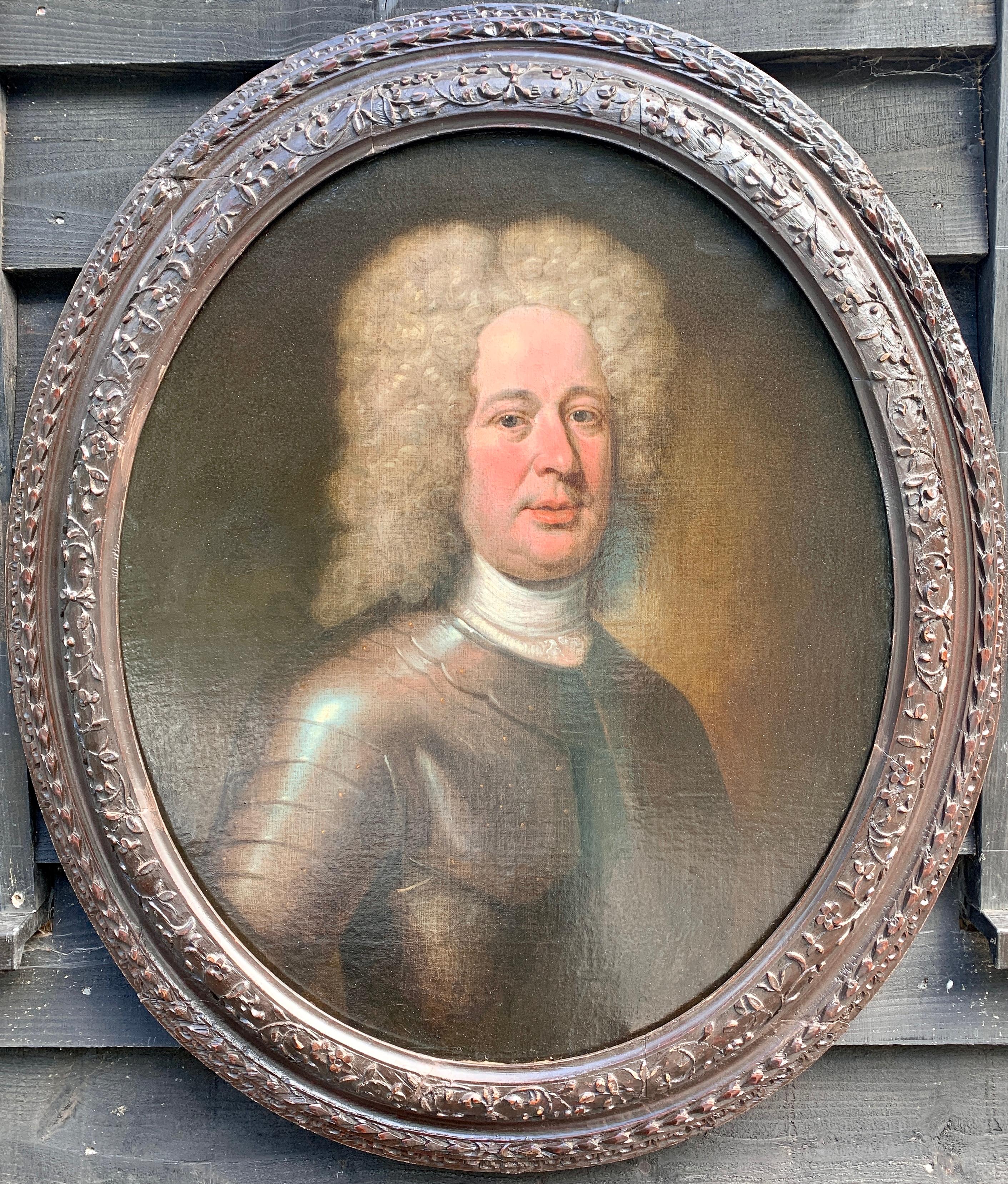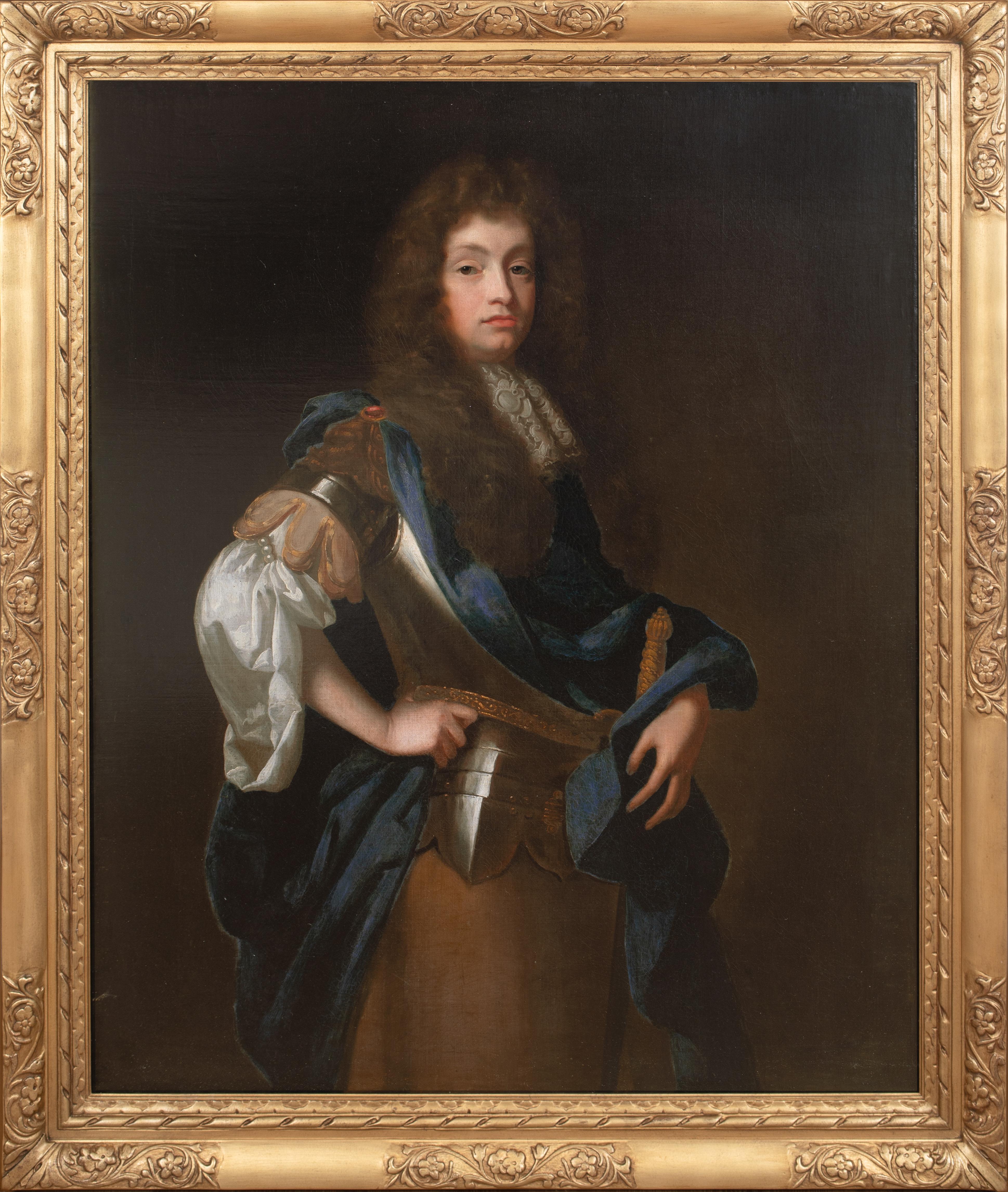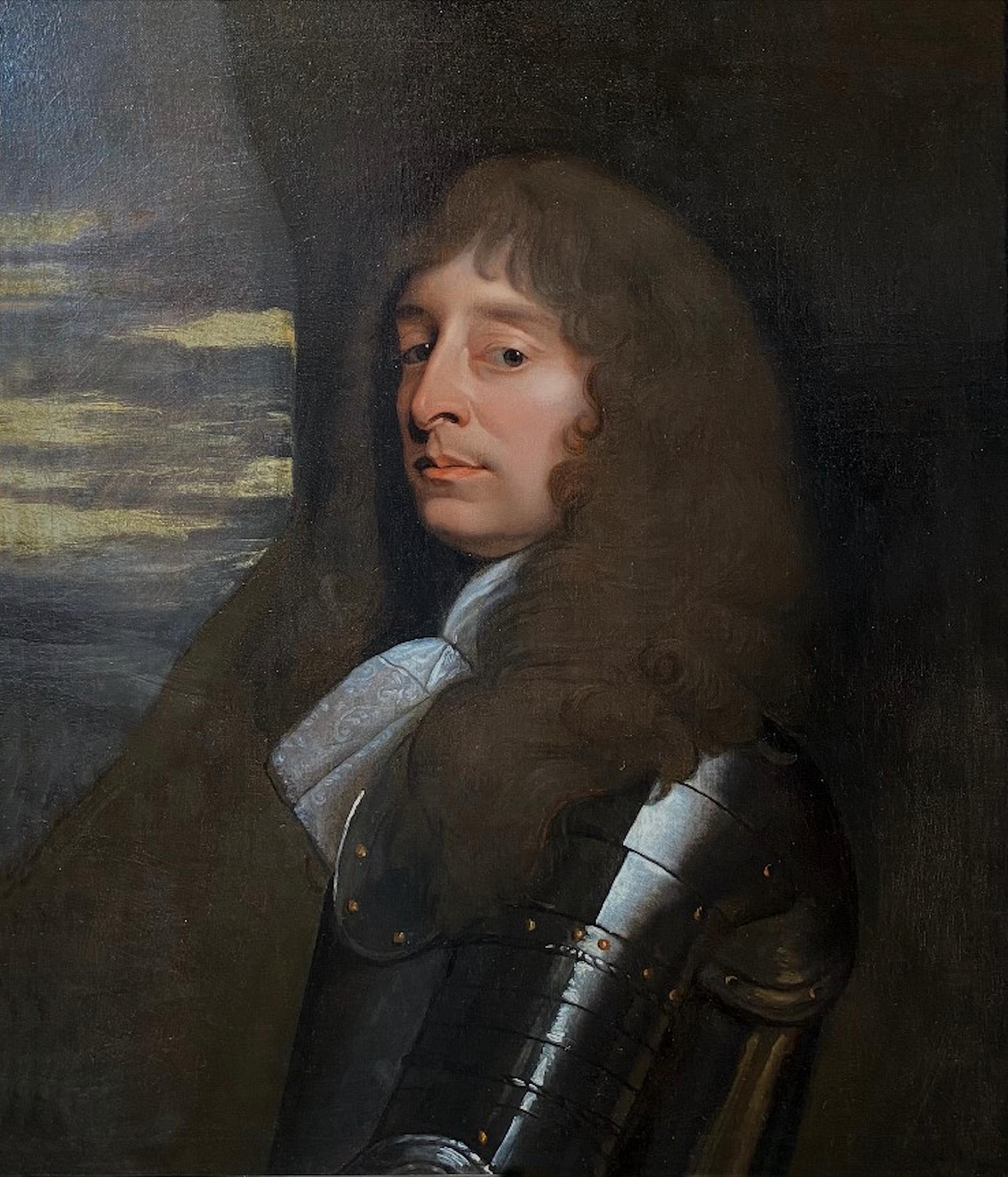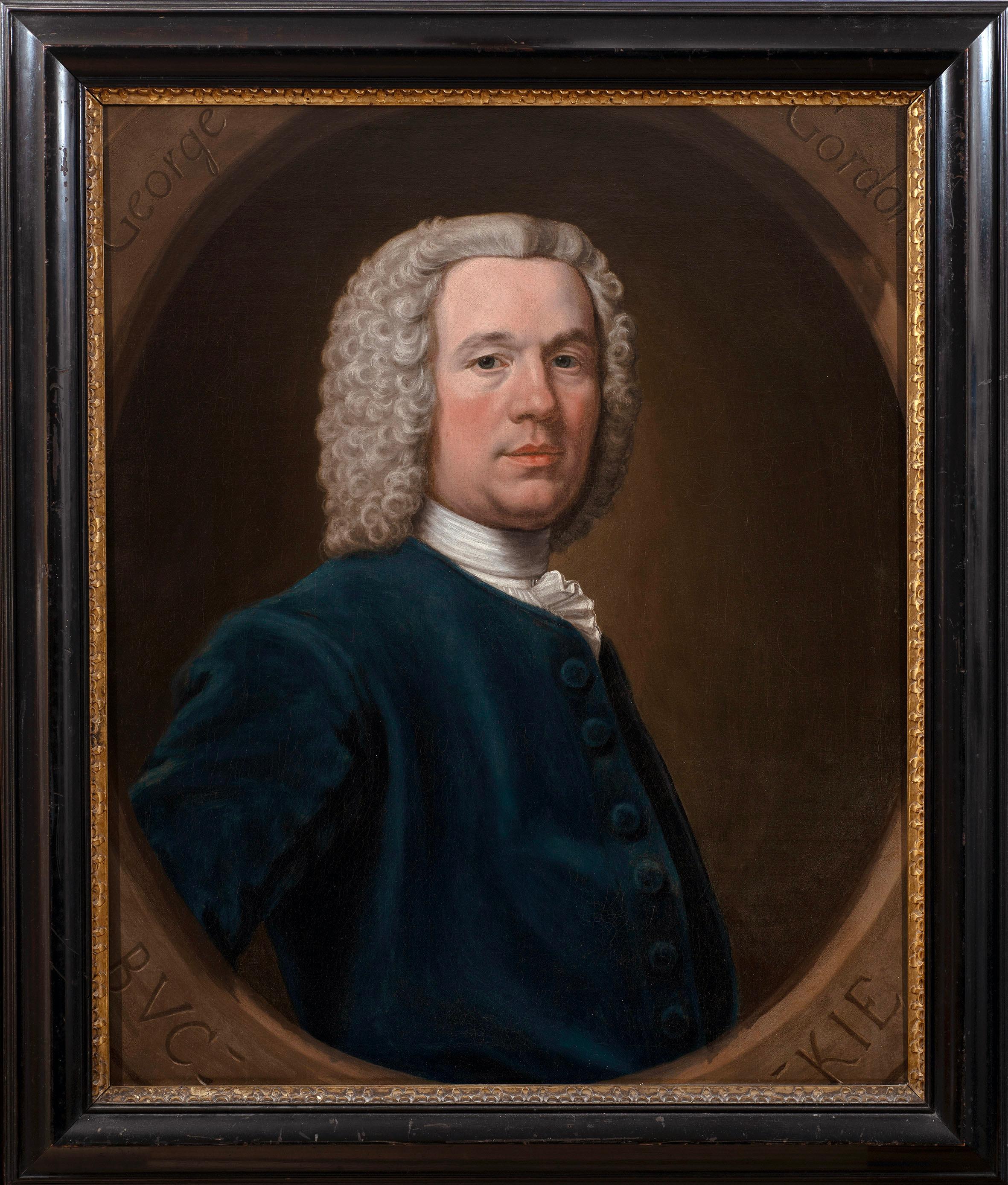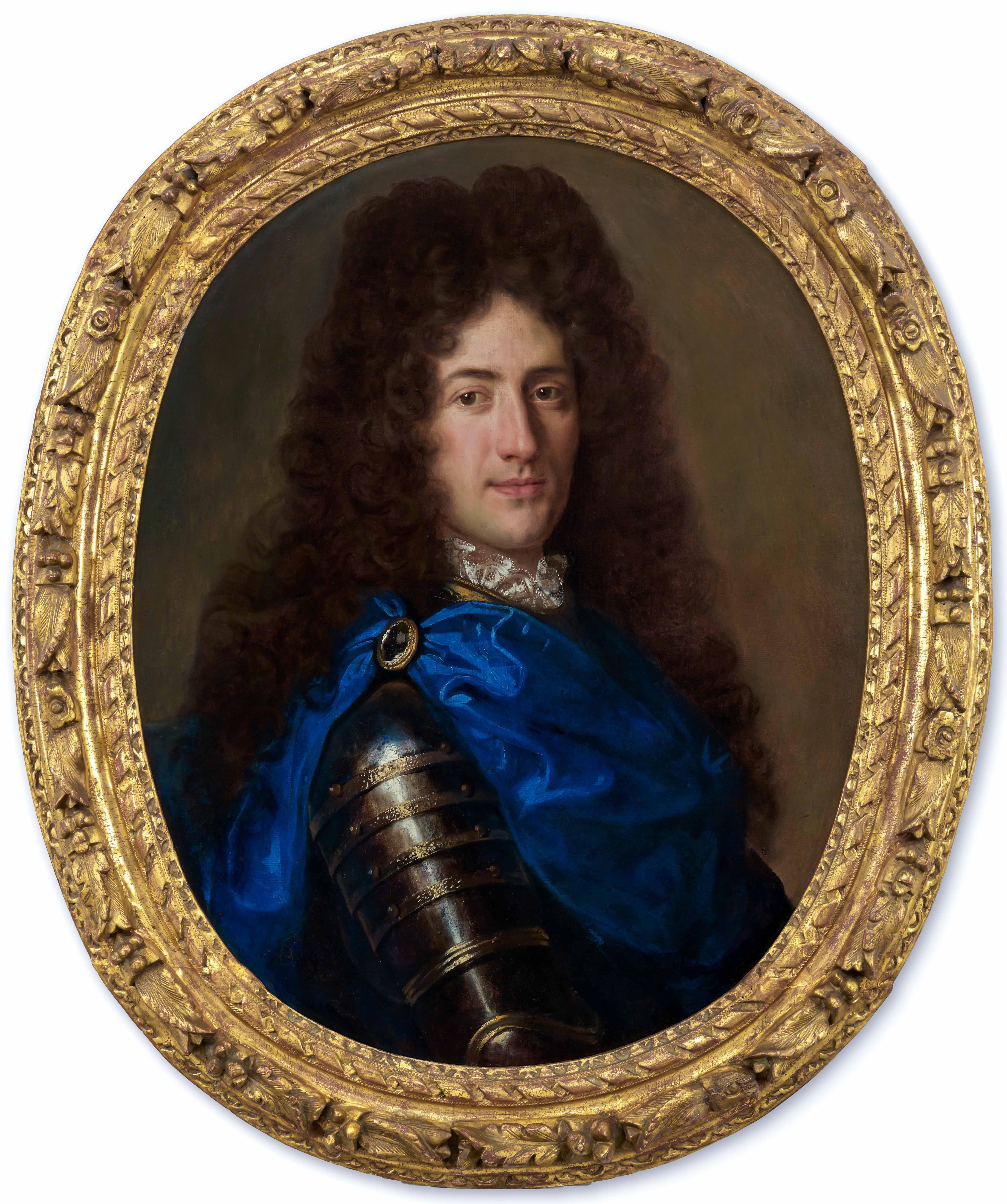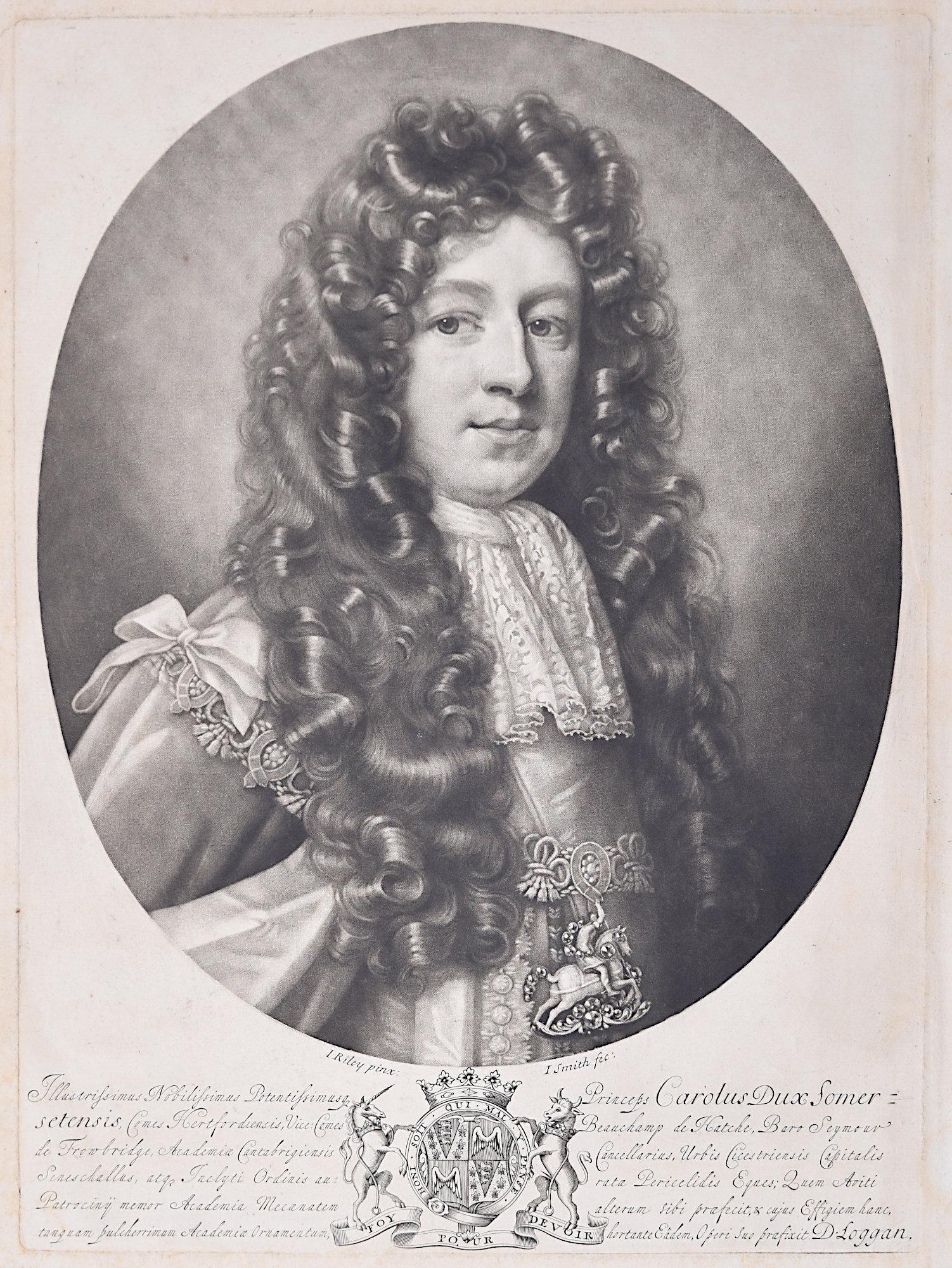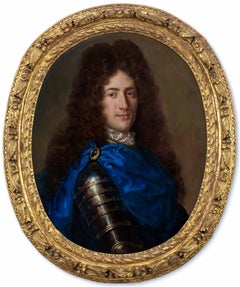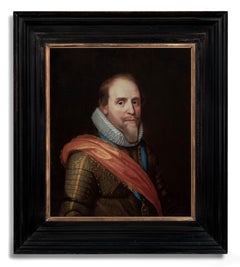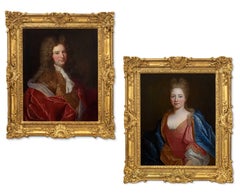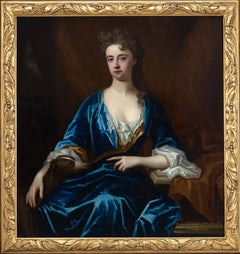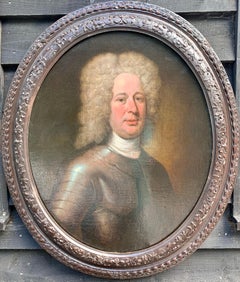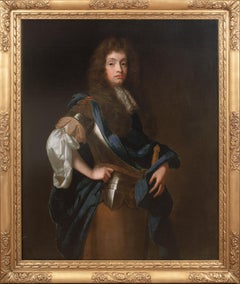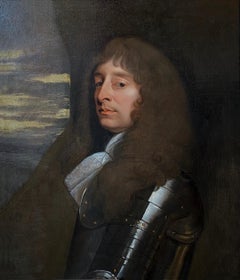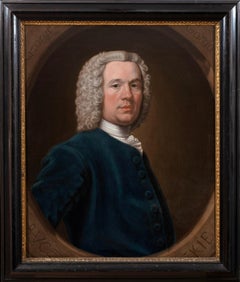Items Similar to Portrait of a Gentleman, David Erskine, 13th Laird of Dun, Wearing Armour c.1700
Want more images or videos?
Request additional images or videos from the seller
1 of 11
Portrait of a Gentleman, David Erskine, 13th Laird of Dun, Wearing Armour c.1700circa 1700
circa 1700
$9,398.85
£6,850
€8,016.47
CA$13,111.19
A$14,222.67
CHF 7,479.08
MX$173,061.20
NOK 93,500.51
SEK 88,182.46
DKK 59,853.18
About the Item
The gentleman in this exquisite oil on canvas portrait, presented by Titan Fine Art, is shown with the grandiloquence characteristic of the English School of painting. He is portrayed wearing an ingeniously embellished armour, a white cravat, and an abundance of cascading curls falling below his shoulders - his heroic visage and martial-like characterisation are suitably reflected in these costly items. This portrait proclaims to every onlooker that this man is both authoritative and important but such fine and ornate armour was not actually used on a battlefield and thus its portrayal here was largely symbolic. It is the archetypal bust-length portrait for a wealthy male during the last quarter of the seventeenth century and first quarter of the next.
The subject is said to be the Scottish lawyer and commissioner to parliament, David Erskine, the 13th Laird of Dun. He was known for his considerable experience and distinguished piety. Born in 1672 near Montrose in Angus, he pursued his studied at the universities of St. Andrews and Paris. He became a member of the Faculty of Advocates in 1698 and quickly gained prominence. He represented Forfarshire at the Convention of Estates in 1689 and was also active in the parliaments of 1690, 1691, 1693, 1695, and 1696, where he opposed the Union.
In November 1710, he assumed his position as an ordinary lord under the title of Lord Dun, and in 1714, he was appointed a Lord of Justiciary. Although a Jacobite at heart, he was incredibly influential in the Hanoverian regime. It is remarkable that Erskine kept his allegiances hidden, and this resulted in him keeping his life and his lands after 1745 when so many Scottish families were torn apart and stricken by the conflict. He died on May 26, 1758.
The House of Dun was the family estate that had passed through generations of the Erskines. They had owned the estate for over 300 years before the sitter in our portrait commissioned William Adam to replace it in a show of wealth and influence in 1743. In 1980, the 21st and last Laird of Dun, died without an heir and left the house and contents to the National Trust of Scotland.
The painter Sir John Baptiste de Medina was born in Brussels in 1659 to a Spanish officer stationed in the Netherlands. He began his career as an apprentice to François Duchatel before relocating to London around 1686 where he employed several assistants in his Drury Lane studio. Although he specialised in portraiture, Medina also illustrated an edition of Paradise Lost, which was published in 1688, and created various subject paintings. He counted several members of the Scottish aristocracy amongst his clients and in 1694 he was persuaded to visit Edinburgh to paint their wives and families, eventually settling there permanently. With virtually no competition in Scotland, Medina was the most prominent Scottish portraitist for the rest of his life, charging £5 for a head and £10 for a half-length.
Around 1700, William Aikman joined Medina’s studio and likely assisted with a commission from the Royal College of Surgeons for a series of 29 member portraits between 1697 and 1708. After obtaining naturalisation, Medina was knighted.
With his distinctive, informal baroque manner, he captured a generation of Scottish society and was knighted in 1706 by the last Scottish parliament before the Act of Union. He died in Edinburgh at approximately 51 years of age in 1710.
The treatment of the hair, and most particularly, the armour, is adeptly painted with precision and shows the commensurate skill of the artist.
Measurements: Height 90cm, Width 78cm framed (Height 35.5”, Width 30.5” framed)
- Attributed to:John Baptiste de Medina (1659 - 1710, Flemish, Spanish)
- Creation Year:circa 1700
- Dimensions:Height: 35.44 in (90 cm)Width: 30.71 in (78 cm)Depth: 2.37 in (6 cm)
- Medium:
- Movement & Style:
- Period:
- Condition:The condition is very good and can be hung and enjoyed immediately. The painting has passed a strict condition assessment by a professional conservator prior to going on sale.
- Gallery Location:London, GB
- Reference Number:1stDibs: LU1199116162942
About the Seller
5.0
Vetted Professional Seller
Every seller passes strict standards for authenticity and reliability
Established in 1998
1stDibs seller since 2019
45 sales on 1stDibs
Typical response time: 1 hour
- ShippingRetrieving quote...Shipping from: London, United Kingdom
- Return Policy
Authenticity Guarantee
In the unlikely event there’s an issue with an item’s authenticity, contact us within 1 year for a full refund. DetailsMoney-Back Guarantee
If your item is not as described, is damaged in transit, or does not arrive, contact us within 7 days for a full refund. Details24-Hour Cancellation
You have a 24-hour grace period in which to reconsider your purchase, with no questions asked.Vetted Professional Sellers
Our world-class sellers must adhere to strict standards for service and quality, maintaining the integrity of our listings.Price-Match Guarantee
If you find that a seller listed the same item for a lower price elsewhere, we’ll match it.Trusted Global Delivery
Our best-in-class carrier network provides specialized shipping options worldwide, including custom delivery.More From This Seller
View AllPortrait Gentleman Armour, Blue Cloak, Diamond Brooch c.1700 French Carved Frame
By Joseph Vivien
Located in London, GB
Portrait of a Gentleman in Armour and Azure Cloak with Diamond Brooch c.1700
Attributed to Joseph Vivienne (1657-1735)
The sitter in this superb portrait, offered by Titan Fine Art...
Category
17th Century Old Masters Portrait Paintings
Materials
Oil, Cotton Canvas
Dutch Old Master Portrait of Maurits, Prince of Orange-Nassau, Oil on Panel
Located in London, GB
In 1607, the Delft city council decided to commission a portrait of Stadholder Maurits of Nassau for the town hall, with Michiel van Mierevelt as the chosen artist due to the passing...
Category
17th Century Old Masters Portrait Paintings
Materials
Oil, Wood Panel
Portrait of a Lady and Portrait of Gentleman, Velvet & Silk Attire c.1700 French
By Nicolas de Largillière
Located in London, GB
These lavish portraits, presented by Titan Fine Art, illustrate the elegant and exuberant type of portrait that the French court and the bourgeoisie favoured at the end of the 17th century. Painted circa 1700, they combine a meticulous representation of the subject's face and rich detailed draperies. They are a mastery of colour and of a style perfected by the prestigious painter and Director of the Académie Royale de Peinture et de Sculpture in Paris, Nicolas de Largilliere.
France during this period was the leading exponent of fashion and the arts to the rest of Europe and the fashions arose from the French court itself – and this is evident in the clothing on display in these portraits. The gentleman has been depicted in a russet coat with golden thread embroidery, a white lace cravat, and a rich crimson velvet mantle, that has been deliberately turned over at the top to reveal its purple shot silk lining. The young beautiful lady, whose face is painted with a clear and fresh palette, wears a dress with golden embroidery on the bodice and a huge black diamond brooch, large balloon-like gathered sleeves with lace and tied with a string of pearls, and a luxurious azure blue velvet mantle, tied at the shoulder with a pearl and large diamond brooch, again, deliberately folded to reveal its real gold embroidered lining. Her cheeks are rosy, with red lips: a style in keeping with that was worn at Versailles. The copious number of expensive fabrics, that completely encircle them, serve to underline their social status.
The skilful works, with their beautiful colour combinations, create a strong visual impact. The artist demonstrates great skill in the rendering of sumptuous fabrics, the use of vibrant colours, and the realism of the faces.
The couple are most likely married, considering the conventions of portraiture at the time, where the male is positioned on the left (and inclined to our right) and the female is positioned on the right (and included to our left).
A feature of these portraits are the stunning original carved and gilded frames – they are works of art in their own right.
Nicolas de Largillierre was baptised in Paris in 1656. His family relocated to Antwerp when he was approximately three years old. After a journey to London, Largillière's father arranged for him to apprentice with the Flemish artist Anton Goubau. Nevertheless, he departed at the age of eighteen and returned to England, where he formed a friendship and was employed by Sir Peter Lely for four years in Windsor, Berkshire. During this period, Largillière also worked under the guidance of the Italian painter Antonio Verrio.
His artwork garnered the interest of Charles II, who desired to keep Largillière in his service; however, he eventually returned to Paris, where he was warmly embraced by the public as a painter.
Upon his ascension to the throne in 1685, James II summoned Largillière back to England and offered him the position of keeper of the royal collections. He subsequently painted portraits of the king, Queen Mary of Modena...
Category
17th Century Old Masters Portrait Paintings
Materials
Canvas, Oil
Portrait of Lady, Barbara Herbert, Countess of Pembroke c.1708, Large Painting
Located in London, GB
Portrait of Barbara Herbert, Countess of Pembroke c.1708
Charles d’Agar (1669-1723)
This magnificent large-scale portrait, presented by Titan Fine Art, depicts the British court of...
Category
17th Century Old Masters Portrait Paintings
Materials
Cotton Canvas, Oil
Portrait of a Gentleman, Doublet & White Ruff, Gloves Inscribed 1624, on panel
By Frans Pourbus the Younger
Located in London, GB
Titan Fine Art presents this exquisite oil on panel portrait depicting a handsome young gentleman in an exuberant black damask doublet. The pose, with one hand holding gloves and the other akimbo, was one that was well-established for gentleman of the upper echelons of society by the time this work was painted. The principle governing portraits at this time was the recording and defining in visual terms of the position of a sitter in society. In addition to brilliant and complex symbols of luxury, they often contained many symbolic elements too; the inclusion of gloves was often used in portraits that celebrated a betrothal as in ancient times gloves were used to seal a marriage contract.
The extraordinary costume of a black shimmering doublet, the brilliant white reticella ruff, and the cuffs edged with lace were immensely costly… this attire proclaims to every onlooker that this is a superior being. The rendering of the reticella lace ruff is exquisite and the artist has recorded the design that runs through the black damask fabric with meticulous attention to detail. The preservation of this black pigment is remarkable considering the age of the work. Black pigments are especially vulnerable to fade and wear over time partly due to environmental condition but also from unprofessional cleaning. This work is an exquisite example from the period.
According to the inscription in the upper right, the gentleman was in his 22nd year of age in 1624. The coat of arms, which is displayed without a crest, may be ‘blazoned’ in the language of heraldry, as: Sable on a Chevron between in chief two Roundels and in base a Billet [or possibly Square] Or three Martlets Sable. In plainer English this means a black (Sable) background, spanned by a gold (Or) chevron, above which are two golden solid circles (Roundels), and below which is a gold rectangle (Billet); on the chevron are three small black birds (Martlets). Martlets are a stylised form of heraldic bird, believed to be based on the swift, which are conventionally drawn with small tufts instead of feet. In Continental Europe it is also conventional for them to be drawn without beaks, as appears to be the case here. The birds in this instance also have a vaguely duck-like appearance.
Five families have been identified with very close armorial bearings to the one in our portrait. They are the (van) Houthem’s (of Brabant), the Prévinaire’s (of Flanders and Holland), and the Proveneer’s (of Liège) and it must be noted that the locations of these families also fit with the painting’s Flemish origins. However the French Grenières’s (of Île-de-France) and the Jallot’s (of Normandy) are the next closest matches and plausible matches, as Frans Pourbus had settled in Paris just a few years before our portrait was painted.
This painting has been assessed by a professional conservator prior to going on sale, and as thus, it can be hung and enjoyed immediately.
Frans Pourbus the Younger...
Category
17th Century Old Masters Portrait Paintings
Materials
Oil, Wood Panel
Portrait of a Gentleman in Doublet & Ruff c.1595; Elizabethan oil on copper
Located in London, GB
Portrait of an Elizabethan Gentleman in a Black Doublet c.1595
Manner of Hieronimo Custodis (died c.1593)
Oil on copper
Unsigned
This exquisite oil on copper portrait, painted around 430 years ago, is a splendid survival from the Elizabethan era - the golden age in England’s history, when Queen Elizabeth I was on the throne. It is a time that is sandwiched between two golden ages of English renaissance culture, the reigns of Henry VIII and Charles I. This period produced a style of painting quite unlike that anywhere else in Europe and one that deserves serious assessment. Just a couple of years after our portrait was painted, English painting developed on another course, driven mainly by the artists Marcus Gheeraerts the Younger and Isaac Oliver; they depicted a new mood that was pervading Elizabethan and Jacobean society, which was that of romantic melancholy. Elizabethan painting...
Category
16th Century Old Masters Portrait Paintings
Materials
Copper
You May Also Like
18th century oil painting English portrait of a gent in armor, wearing a wig
By studio of Sir Godfrey Kneller
Located in Woodbury, CT
Outstanding early 18th century English portrait of James Bellevue.
The portrait was always believed to be the work of Sir Godfrey Kneller who was known to have painted James Bellevu...
Category
Early 1700s Old Masters Portrait Paintings
Materials
Canvas, Oil
$7,960 Sale Price
20% Off
Free Shipping
Portrait Of Richard Jones, 1st Earl Of Ranelagh, 17th Century SIR PETER LELY
By Sir Peter Lely
Located in Blackwater, GB
Portrait Traditionally Identified as Richard Jones, 1st Earl Of Ranelagh, 17th Century
School Of Sir Peter Lely (1618-1680)
Large 17th Century Portrait believed to be Rochard Jones...
Category
17th Century Portrait Paintings
Materials
Oil, Canvas
$9,879 Sale Price
20% Off
Portrait of a Nobleman in Armour, 17th Century Oil Painting
By Anthony van Dyck
Located in London, GB
Oil on canvas
Image size: 30 x 35 inches (76.25 x 89 cm)
Carved gilt frame
A half-length portrait of a man turned slightly to the left, gazing at the spectator, standing, wearing st...
Category
17th Century Portrait Paintings
Materials
Canvas, Oil
Portrait of George Gordon, 7th Laird of Buckie (1707-1756)
By John Alexander
Located in Maidenhead, GB
John Alexander (Scottish, 1686-1766)
Portrait of George Gordon, 7th Laird of Buckie (Scottish, 1707-1756), c. 1743
Oil on canvas
In a carved ebonised frame, with gilded inner slight...
Category
1740s Old Masters Portrait Paintings
Materials
Oil
David Loggan Cambridge portrait Charles Duke of Somerset 1690
By David Loggan
Located in London, GB
To see our other views of Oxford and Cambridge, scroll down to "More from this Seller" and below it click on "See all from this Seller" - or send us a message if you cannot find the view you want.
David Loggan (1634-1692)
Charles Duke of Somerset...
Category
1690s Realist Prints and Multiples
Materials
Mezzotint
Armorial Portrait Painting of a Nobleman, the Netherlands, circa 1760
Located in Kinderhook, NY
Exceptional quality oil on canvas portrait painting of a bewigged Dutch statesman in armour having architectural background of ancestral seat with heraldic crest at lower left. Later...
Category
Antique Mid-18th Century Dutch Baroque Paintings
Materials
Canvas, Paint, Wood
